
We are proud to present an artist of rare talent-previously only seen in the western World. Nirmal's impressive bio-data, his work and commendations are a plume in his artistic hat. An asset to the Sikh-Art and Heritage. (Harjinder Kanwal)
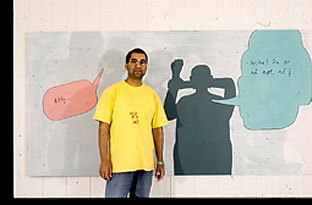
A
point of departure: From Jandiala, Punjab, India to Trondheim, Norway
Nirmal
Singh Dhunsi (above) was born into a Sikh family around 1960
in
the village of Jandiala, Punjab. He describes his family as extremely colourful
with a father who began to convert to Islam and an aunt who developed strong Hindu
beliefs, not by any means a traditional Sikh family. Nirmal's family belong to
the craftsman cast and through his fathers and grandfathers work-shops he came
into early contact with local craft traditions in which the craftsman is architect,
carpenter, painter and decorator. As a teenager he was apprenticed to a master
in a nearby village to learn the traditions of miniature painting. These skills
were put to use in temple decorations, funeral portraits and the decoration of
house facades. Later he began to work for the film industry in Punjab painting
massive scale realistic film posters. This was the beginning of a desire to study
European art abroad.
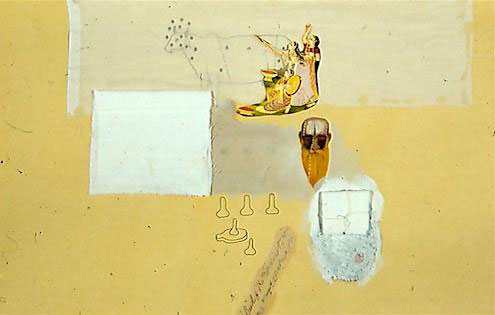
On
advice from an acquaintance that was studying at Oslo University he came to Norway
in 1984. In 1987 he was accepted to study at the academy of art in Trondheim and
during the first few years experimented with different aspects of modernism, such
as cubism and expressionism. He wanted to work his way through the European modern
tradition, as he puts it "So that afterwards I could start in the present..."
In the course of his last years at the academy he became more and more interested
in returning to his own cultural inheritance for inspiration. Large canvases were
flooded with layer after layer of repeated brush strokes, glowing red and gold
earth colours and small circles functioning as an abstracted written language.
The concentration of this method can be equated with meditation, a search after
an existential present that is a meeting between western abstraction and Indian
mysticism.
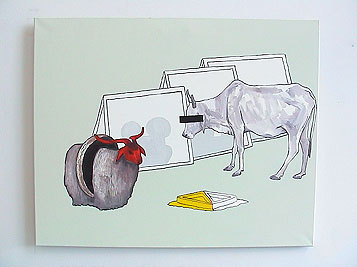
A
kind of "All over" painting not unlike the zen-inspired works of the
American artist Mark Toby. In retrospect Nirmal views these paintings as too strongly
influenced by existing visual language. An important impulse in the search for
something more personal was his encounter with the work of Joseph Beuys and the
Anglo Indian installation artist Anish Kapoor who's strongly coloured sculpture
unites Indian mysticism with an abstract from language.
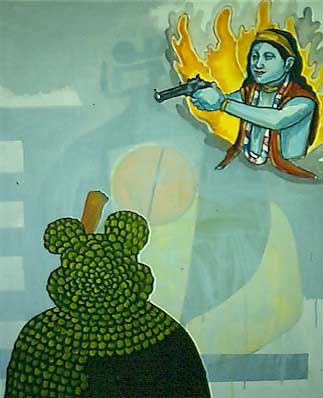
The journey home
In 1991 Nirmal revisited and travelled around
India visiting the major cites, art schools and arts community. He says "When
I travelled back to India my understanding of Indian culture was much greater,
I suddenly felt myself rich in a rediscovered raw material, I had acquired an
understanding of contemporary art, of visual language, now I could travel back
and gather my own experiences and work with them. It was a turning point."
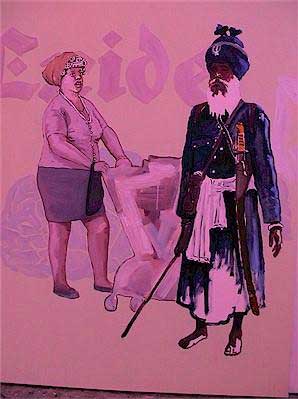
To
meet again Indian religious rituals, local traditions and myths was a powerful
experience. He recorded rituals in peoples homes where statues of gods were fed,
decorated with flowers and coloured textiles. Coloured pigments, red, yellow,
orange were smeared onto the statues and when it was time for the gods to "rest"
they were covered in material.
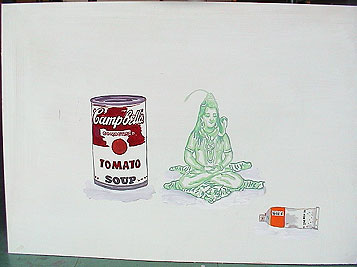
Other rituals included the decorative patterns drawn in the streets with rice
flour. He experienced these actions as unselfconscious, natural almost automatic.
This came to have great meaning in his search for a similar unselfconscious working
process.
These impulses caused a radical change in his working method; back
in Trondheim he exhibits an installation at the Trondheim arts association; spread
over the floor are small piles of flour and white pigment together with pigment
in plastic bags. The
elements are placed and sorted but not hierarchically.
On the floor is a bundle with something in it, as if to indicate a small private
ritual of a traveller. Candles and leafs. Strong colours. White and black. Red
and yellow to symbolise wisdom and life. A charcoal drawing on the wall depicts
a mythic beast with a cow's body and bird head. The work lies somewhere between
a ritual place and installation art. He had begun his search after his own voice.
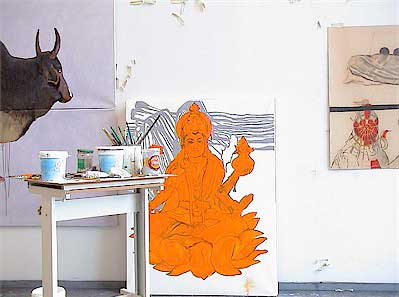
A
thousand drawings
"Playfulness has always been important to me, it's
a way of
communicating with the spectator and with myself."
Freely
placed on the white paper we see line drawings of self satisfied chubby men with
stubby beards and pot bellies. On their head a small turban, the rest of the body
is naked. They all have same facial expressions and the same turbans as if they
are variations of the same character (a self-portrait?). Some sit, others crawl
on all fours, they converse about something, we are witness to a situation without
fully being able to understand what is
happening. A head rests up side down
on the back of a rodent.
A mythical beast stands in the background. There
is something secret and sensual about the drawings, however they are more than
just a play, they are the result of a continual process of development through
the 90s, a reworking of experiences from India and Europe but seen from a distance,
filtered through a deep knowledge of western cultural history and international
art language. Thousands of drawings of which only a tiny number have been selected
and shown. Central to this body of work is the awareness that his cultural inheritance
can only be a source of contemporary relevance if viewed with a certain detachment.
"It should be obligatory; we must leave the place we come from to reach
new understandings! When I travel back I can respond to things that before were
just a part of the natural order of things. First you ad apt to the local traditions
and then you go where everything is different. Then it's exciting to work with
yourself! Then there are dynamic contrasts!"
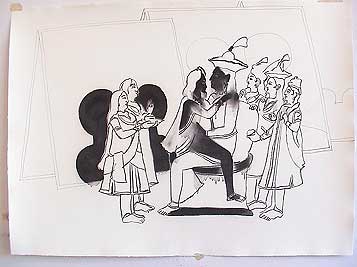
In
many of the drawings something is scribbled in Urdu. We may believe that here
lies a hidden explanation, a commentary to the figures activities, but we can
only guess, the text is first and foremost a visual element (one text fragment
can be taken from ancient texts, another place there may be written "bla
bla bla!" - in Urdu). At the same time these fragments represent a sound
element, something to be read aloud. A rhythm. In Indian miniature painting there
is a tradition of text ( sound ) in imagery. It is this concept he uses. Kangra
painting, miniature painting in the Punjab originated in the 1600s. Motives are
mostly from the religious and mythological pantheon and this form of painting
is still practised in daily life, it is to be encountered in both original and
reproduction form. The images are distinctive in a richly detailed depiction of
gods and mortals, animals and plants, often stylised with emphasis on the decorative
qualities. Nirmals drawings have many of the same qualities. With ease and elegance
he constructs his own histories where simple scenographic elements in the form
of geometric cubes become tables, stones or architectural elements depending on
what activities the figures are involved in.
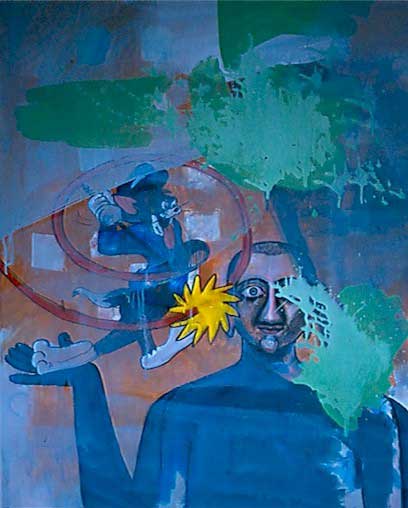
Looking
for stories not yet told
Nirmal wishes to involve both himself and the
spectator in an open reflection over what expectations one can have as to what
art should be, and what it can tell us. He is concerned with how similar all references
can be living in a contemporary information society - where the same story is
told and retold - and asks himself to what extent it is possible to experience
anything unexpected. For Nirmal it is important that the aesthetic and technical
actions that he uses refer to something experienced. What he seeks to achieve
is to combine visual elements in a way that communicates the unexpected, something
not yet told.
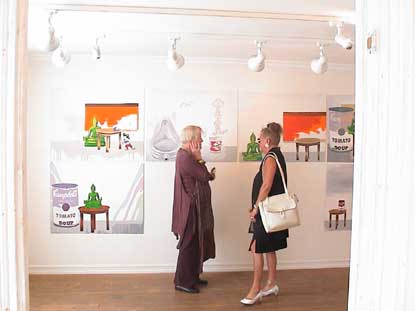
The process of combining different images and materials is experimental and intuitive, with a clear relationship to rituals such as the use of rice flour to draw decorative patterns. When he hides something in the image behind a layer of paint or cheese cloth he reflects the tradition of covering household idols on special occasions. In a similar way elements of white cardboard can refer to architectural elements observed in the Punjab.
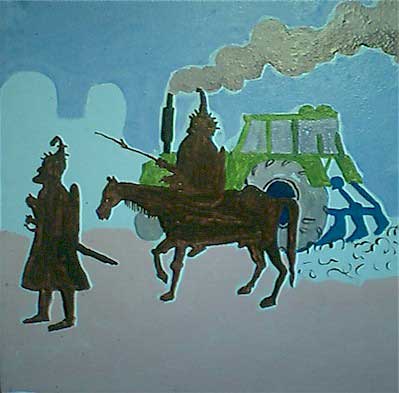
Fascinated
by the tensions between the abstract and the referential, he has worked with a
series of collage like images where different materials and techniques are combined
to evolve a diverse and complex form of expression. Fragments of Indian miniature
painting have been applied to canvass and cardboard, reproductions and originals,
with motifs from sagas and myths; blue gods, beautiful women, decorated elephants,
palaces and gardens. In contrast to these Indian elements have been placed elements
of textile in clear colours, string is fastened to nails to form different structures,
cheese cloth is stretched over, partially concealing the painted figures. The
spectator will often meet partially concealed elements, previous experiences that
are in the process of being sublimated by new events. Here and there the surface
is smeared with powerfully applied brushed paint, without apparent representative
intention other than the trace of modernisms expressive brush stroke.
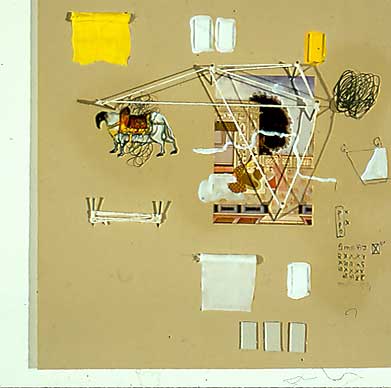
The
use of original miniatures is interesting in this context. It is as if there is
a commentary to the relationship between European modernism - "the eternal
universal art"- and images connected to ritual and religious traditions.That
European modernism was inspired by non European art is a truth that can not be
repeated often enough. Cubism and expressionism are the direct result of an encounter
with African art. Chinese, Japanese and Indian art have also played their part.
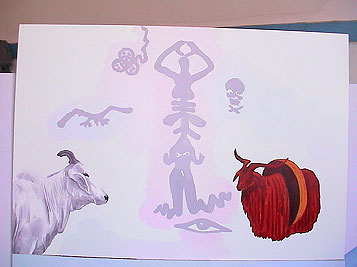
A central aspect here is that European modernism created eternal universal and "free"art out of some-thing that was not "art"at all, but fetishes, "magic images", connected to local ritual traditions. This distinction has been decisive in for the dominance of western orientated art. In the work "East, west" Nirmal breaks down this distinction between contemporary art and traditional ritual art.
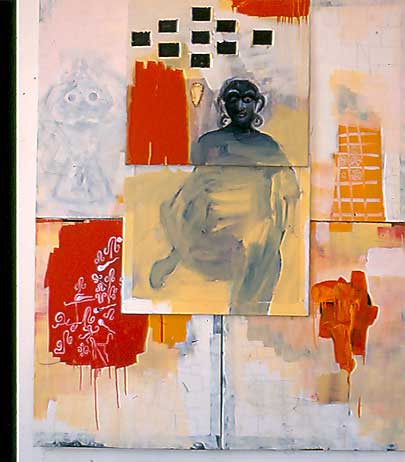
We see a grey painted plane with drawings of a naked man (the figure), a head (the self portrait) partially concealed by cheese cloth. In the main area of the painting we see a series of quadratic cardboard elements painted yellow and white. The painting is dominated by a modernist visual language in which the abstract elements appear to have a purely formal aesthetic function. However the central visual element is infact a small hand painted miniature mounted on the canvass. This little painting depicts a column of regally dressed riders.
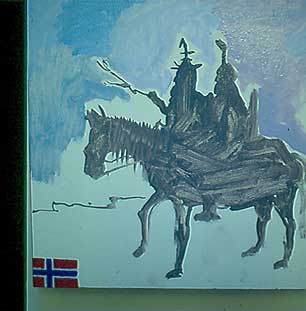
It
appears that the image is quickly painted, to an established formula, it is reminiscent
of religious kitsch, a picture that may decorate a home and perhaps have a ritual
function. This little image is also partially covered with a thin layer of paint,
an expressive gesture, not unlike the rest of the painting. The artist has also
mounted small painted pieces of cardboard on the miniature, an act that generates
an ambiguity; is this a part of a ritual or is the intention purely aesthetic?
Through this ambiguity the original miniature becomes contemporary - at the same
time making possible the question as to what extent the entire paintings existence
belongs to a pre defined ritual, Art defined as ritual.
Shiva and Mickey, Jerry and Krishna
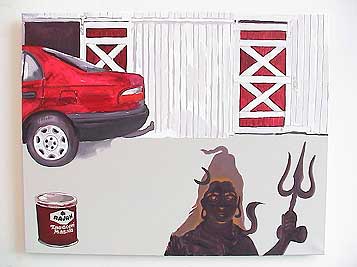
The
newest paintings signal a shift in expressive form. The previously intimate formats
are replaces with more monumental dimensions. In many of the paintings clear planes
of colour
dominate. The drawn and material poetic has given way to a more
unified and "clean"painting populated by silhouettes and simple signs;
the diversity of motifs is reduced, but in return more clear in its communication.
A male figure with many arms is a repeated element, gazing out towards something
distant, like the transcendental gaze we know from some Buddha figures; a more
earthly version of the Hindu god Shiva? God of the creative and destructive powers.
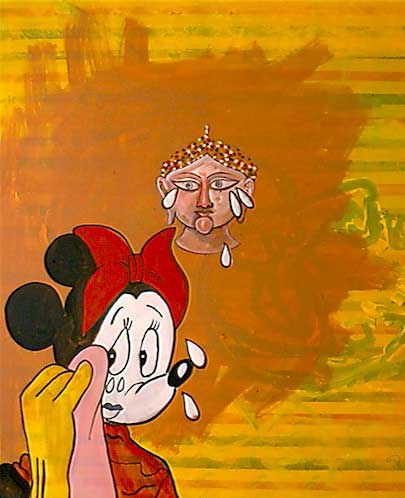
The
artists mental self portrait? In one example the face is painted in a white pallet.
We see silhouettes of lovers, taken from the Indian guide to erotic love, the
Karma Sutra. There is a lot of nudity in Nirmals paintings, he like to take a
kick in the direction of moral prurience. We see couples, man and woman, but rarely
in a position that reveals the sexual nature of the image explicitly. The positions
yoga like quality giving them an ambiguity. Some compositions focus on strings
of pearls, enlarged prayer bracelets, draped across the image surface and similar
to the jewels that grace the characters in the miniatures. Many of the pictures
are built up of layers, like double exposures, where in the lower levels we can
glimpse half erased figures. Foremost in the image plane hang clearly drawn prayer
bracelets. Strings of pearls are held up in front of our gaze, and the background
events are forced out of our focus.
In the painting "Sign"these
pearls form a perfect circle. Behind we can glimpse a number of silhouettes. We
think of Renaissance art's use of geometry in both the human body and composition,
but here the figures escape us and do not allow themselves to be controlled by
the template of symmetry.
A new and surprising element that has come into
play are well known cartoon characters who now mix themselves in among the erotic
silhouettes. Mickey Mouse and Goofy, Tom and Jerry.
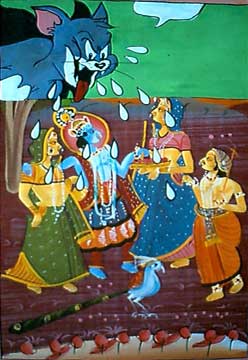
Speech bubbles with and without text, give a voice to both the Indian gods and cartoon celebrities. The gods are pulled down from their pedestals, pulled out of their mystic time and become a part of entertainment culture. With a somewhat surprised expression they address us directly with the aid of the cartoons simple methodology. Laughter is just under the surface and cheeky treatment of the gods is clear for all.. Nirmal wants to make the figures speak "to make them say something they shouldn't have said, something other than what the religious commandments say"
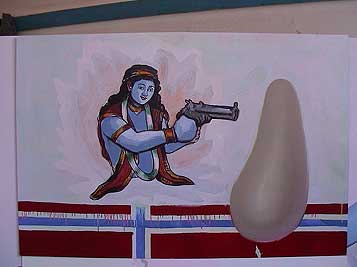
Empty
speech bubbles stand themselves as a sign for sound as if the very surface of
the canvas itself wished to say something or perhaps as a possibility for the
spectator to insert their own voice. The artist invites the public to give the
sign meaning.
But don't cartoon heroes actually represent our own myths? They
are also invincible, immortal like their Indian companions. Animals that act like
humans, anthropomorphized to act as carriers of archetypal powers. The battle
between good and evil. Pride and greed, like the classic dramas. We have all read
our Karl Barks. In Nirmals pictures cartoon characters and gods are equal actors.
In a painting called "Friends"the meeting is particularly set
on
edge; under a thin layer of paint we see the cat Tom in the moment that he, with
a wonderful grin, hits a blue grey god figure. The swing is described by a red
painted spiral that depicts the clubs passage through the air. A fresh yellow
star flies from the point where the blow lands; cartoon languages sign for violence!
The victim is wide mouthed in surprise. The four armed god is describe in near
cartoon style with a clear black contour. This graphic style is met with a powerful
explosion of green colour. The paint has been thrown at the canvass, it sprays
out over the figure and clings to one of the gods eyes. A classic trick from silent
film comedy. The colour spray creates an outer surface
that gives us a glimpse
of the event as if through a dirty window. A large part of the painting surface
has thereby become a pure action painting, where the violent gesture, with its
connection to American abstract expressionism, represents late modernism power.
Not a spontaneous, but a calculated effect. Disbelieving, the god stands caught
between trivial literature and western modernism - what an attack on its dignity!
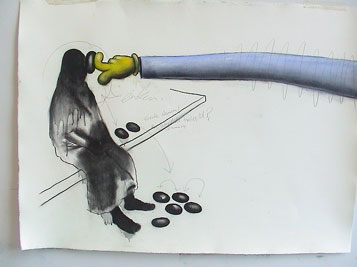
Nirmal
Singh Dhunsi has said that he regards the artistic process as a place where experiences
of the contemporary, and reactions to meeting "that which is different"
can be processed. An artistic project that is constantly in touch with the experiences
of life must necessarily be in constant change. That is why it is important
for him to constantly challenge assumptions, both in the aesthetic and the thematic
aspects. All cast systems must be confronted with alternatives. The powerful brush
stroke, running paint, found materials, reproductions, realistically depicted
figures, text, cartoon characters and gods are all part of Nirmal's visual laboratory
where aesthetic categories are broken down and opened up for different points
of view. Thus can the unexpected and the surprising be said with both traditional
and new methods. Nirmal also has full trust in the publics' ability to join in
this creative process.
Comments by Pierre
Lionel Matte
Translated by Alex Booker
How to get traditional
things
to say something new
"You can't live with two or more cultures;
many of the values you have form the one culture are worth nothing in the other.
Instead you have to build on the experiences you have from your previous culture
and the one that you live in now. You must make your own culture, create your
own personal norms..."
This is how Nirmal Singh Dhunsi describes the
experiences that have influenced his artistic process and establishing a life
in Norway. It's about meeting a new way of life with openness and curiosity to
make possible a continual revaluation of personal identity in which both the present
and the past are integrated.
Throughout the 90s Nirmal's work has been concerned
with building his own visual language, to find a voice and space in which to flourish.
The linking quality for his many drawings, collages and paintings is a fragmented
and spacious image world, with references to everything from Indian miniature
painting and religious rituals to modernist tendencies such as abstract expressionism,
eroticism, geometry and colour symbolism. The work has a stylistic breadth, from
precise and detailed ink drawings to apparently random flecks colour, from applied
bits of cardboard and reproductions to swathes of textile. In some works the images
are partially concealed under a thin veil of paint or partially transparent cheesecloth.
Other places we are confronted by passages of intense colour. This is work that
awakes our curiosity, and we may notice that humour is never far away.
Artists
who use visual reference from a non western tradition often risk being viewed
foremost as decorative, an ethnic component in a culture that desires to be viewed
as multicultural and open. Nirmal has placed his artistic production in an ambiguous
space between cultures. It is as if he is arranging an incomplete puzzle, in which
the fragments jump in contradictory directions. We think that we have found the
key only to discover a detail that confuses our understanding and we are again
left to our ability to impose an interpretation or ask a new question. As Nirmal
says "Its boring if you tell the whole story..."
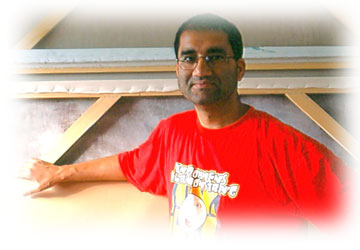
Nirmal has often pointed out that his artistic process represents a space where his experiences of India and Europe can illuminate each other in relation to the reality of his life.
SOME MORE RECENT ART OF NIRMAL




